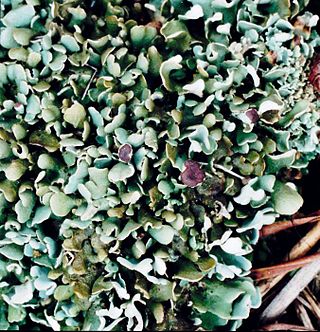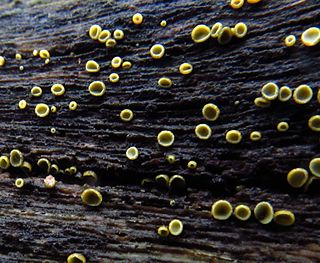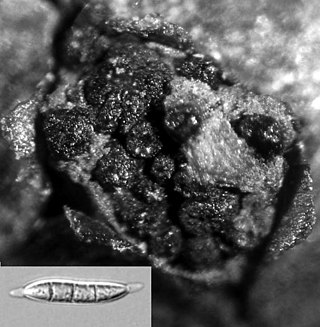
The Saccharomycetaceae are a family of yeasts in the order Saccharomycetales that reproduce by budding. Species in the family have a cosmopolitan distribution, and are present in a wide variety of habitats, especially those with a plentiful supply of carbohydrate sources. The family contains the species Saccharomyces cerevisiae, perhaps the most economically important fungus.

Lecanoromycetes is the largest class of lichenized fungi. It belongs to the subphylum Pezizomycotina in the phylum Ascomycota. The asci of the Lecanoromycetes most often release spores by rostrate dehiscence.

The Dermateaceae is a family of cup fungi in the order Helotiales. Most species in this family are plant pathogens but some are saprobes. These fungi are commonly referred to as "earth tongues" or "earthfan fungi" due to their distinctive appearance.

Diaporthales is an order of sac fungi.

The Amphisphaeriaceae are a family of fungi that is mainly found in parts of New Zealand, South America, Asia and parts of Europe. According to the 2007 Outline of Ascomycota, there were 41 genera placed within the family, although the position of 13 of those genera is uncertain. The 2020 Outline of Fungi and fungus-like taxa severely reduced the family to 4 members.

The Hyaloscyphaceae are a family of fungi in the Helotiales order. Species in this family have a cosmopolitan distribution, and are saprobic, growing on dead wood and other plant matter.

The Helotiaceae are a family of fungi in the order Helotiales. The distribution of species in the family are widespread, and typically found in tropical areas. There are 117 genera and 826 species in the family.

Peltigerales is an order of lichen-forming fungi belonging to the class Lecanoromycetes in the division Ascomycota. The taxonomy of the group has seen numerous changes; it was formerly often treated as a suborder of the order Lecanorales. It contains two suborders, eight families and about 45 genera such as Lobaria and Peltigera.

The Lecanorales are an order of mostly lichen-forming fungi belonging to the class Lecanoromycetes in the division Ascomycota. The order contains 26 families, 269 genera, and 5695 species.
Bimuria is a genus of fungi in the family Melanommataceae; according to the 2007 Outline of Ascomycota, the placement in this family is uncertain.

The Melanconidaceae are a family of fungi in the order Diaporthales, class Sordariomycetes.

The Dipodascaceae are a family of yeasts in the order Saccharomycetales. According to the 2007 Outline of Ascomycota, the family contains four genera; however, the placement of Sporopachydermia and Yarrowia is uncertain. GBIF accepted all the species and also added Magnusiomyces' and Protendomycopsis to the family. Species in the family have a widespread distribution, and are found in decaying plant tissue, or as spoilage organisms in the food industry.
The Microthyriaceae are a family of fungi with an uncertain taxonomic placement in the class Dothideomycetes.
The Parmulariaceae are a family of fungi with an uncertain taxonomic placement in the class Dothideomycetes.

The Rhytismatales are an order of the class Leotiomycetes within the phylum Ascomycota.

The Thelebolales are an order of the class Leotiomycetes within the division Ascomycota. It contains the single family Thelebolaceae, circumscribed in 1968 by Finnish mycologist Finn-Egil Eckblad.

The Rhytismataceae are a family of fungi in the Rhytismatales order. It contains 55 genera and 728 species.

The Lasiosphaeriaceae are a family of fungi in the Ascomycota, class Sordariomycetes.
The Gymnoascaceae are a family of fungi in the Ascomycota, class Eurotiomycetes.















